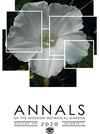Vestured Pits in Wood of Onagraceae: Correlations with Ecology, Habit, and Phylogeny1
IF 1.3
3区 生物学
Q3 PLANT SCIENCES
引用次数: 2
Abstract
Abstract All Onagraceae for which data are available have vestured pits on vessel-to-vessel pit pairs. Vestures may also be present in some species on the vessel side of vessel-to-ray pit pairs. Herbaceous Onagraceae do not have fewer vestures, although woods with lower density (Circaea L. and Oenothera L.) have fewer vestures. Some Onagraceae from drier areas tend to have smaller vessel pits, and on that account may have fewer vestures (Epilobium L. and Megacorax S. González & W. L. Wagner). Pit apertures as seen on the lumen side of vessel walls are elliptical, occasionally oval, throughout the family. Vestures are predominantly attached to pit aperture margins. As seen from the outer surfaces of vessels, vestures may extend across the pit cavities. Vestures are usually absent or smaller on the distal portions of pit borders (except for Ludwigia L., which grows consistently in wet areas). Distinctive vesture patterns were observed in the several species of Lopezia Cav. and in Xylonagra Donn. Sm. & Rose. Vestures spread onto the lumen-facing vessel walls of Ludwigia octovalvis (Jacq.) P. H. Raven. Although the genera are presented here in the sequence of a recent molecular phylogeny of Onagraceae, ecology and growth forms are more important than evolutionary relationships with respect to abundance, degree of grouping, and morphology of vestured pits. Designation of vesture types is not warranted based on the distribution of named types in Onagraceae and descriptive adjectives seem more useful, although more data on vesturing in the family are needed before patterns of diversity and their extent can be fully ascertained. Vestures are less common and may have a more complicated genetic basis than helical thickenings in vessels, but may be a more effective form of water column maintenance.玛瑙科木材中的残留坑:与生态、习性和系统发育的关系1
摘要所有有数据可查的龙脑科植物的血管对上都有凹陷。灶神器也可能存在于一些物种中,它们位于船-射线坑对的船侧。虽然密度较低的树林(Circaea L.和Oenothera L.)的覆盖物较少,但草科的覆盖物并不较少。一些来自干旱地区的Onagraceae往往有较小的容器坑,因此可能有较少的外壳(Epilobium L.和Megacorax S.González&W.L.Wagner)。在整个家族中,血管壁管腔侧的凹坑孔径是椭圆形的,偶尔是椭圆形的。遗迹主要附着在坑孔边缘。从血管的外表面看,覆盖物可以延伸穿过凹坑。灶神甲通常在坑边界的远端部分缺失或较小(路德维希L.除外,它在潮湿地区持续生长)。在Lopezia Cav的几个物种中观察到了独特的服饰模式。和Xylongra Donn。Sm.&Rose。八瓣路德维希(Ludwigia octovalvis,Jacq.)P.H.Raven的前庭分布在管腔对面的血管壁上。尽管这些属是在最近的一个Onagraceae分子系统发育序列中出现的,但就丰度、分组程度和坑的形态而言,生态学和生长形式比进化关系更重要。虽然在完全确定多样性模式及其程度之前,还需要更多关于该家族中的vesture的数据,但根据已命名类型的分布,没有必要对vesture类型进行命名,描述性形容词似乎更有用。遗迹不太常见,可能比血管中的螺旋增厚有更复杂的遗传基础,但可能是一种更有效的水柱维持形式。
本文章由计算机程序翻译,如有差异,请以英文原文为准。
求助全文
约1分钟内获得全文
求助全文
来源期刊
CiteScore
3.60
自引率
0.00%
发文量
15
期刊介绍:
The Annals of the Missouri Botanical Garden is a quarterly international journal primarily devoted to systematic botany and evolutionary biology. We encourage submissions of original papers dealing with significant advances in the taxonomy, phylogeny, biogeography, paleobiology, and evolution of plants, and in conservation genetics and biology, restoration ecology, and ethnobiology, using morphological and/or molecular characters, field observations, and/or database information. We also welcome reviews and papers on conceptual issues and new methodologies in systematics. Important floristic works will also be considered. Symposium proceedings discussing a broader range of topical biological subjects are also published, typically once a year. All manuscripts are peer-reviewed by qualified and independent reviewers.

 求助内容:
求助内容: 应助结果提醒方式:
应助结果提醒方式:


